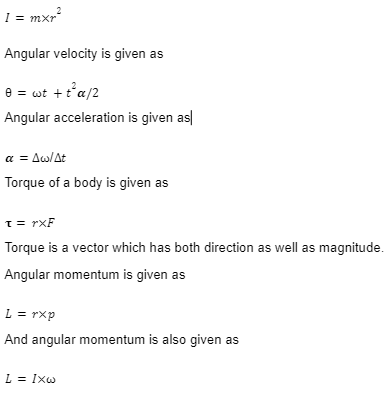In the case of rotational motion or movement, we know that the particles of the body follow a circular path during the movement. Each particle in the rigid body moves in a circular path along a plane normal to the axis and centred on the same axis. There can be two rotary motions, one about the fixed axis and the second about a non-fixed axis. Examples of rotation about a fixed axis are the fan, while for the non-fixed axis the spinning top is a best example.
Rotational Motion
Pure Rotational motion is defined as the motion of an object about a fixed axis. When a rigid body is moved in such that all the particles constituting it experiences circular motion about a common axis then the motion is known as rotational motion.
The rotational motion of a rigid body around a defined axis is a special case of rotational movement. During the rotational motion or movement there is also the possibility that the axis changes its orientation. We cannot explain the concepts of oscillation or precession using the fixed axis hypothesis for rotational motion.
Rigid Body
A rigid body is a body which has a perfectly defined and unchanging shape, no matter how the body moves, the distance between any of the two particles inside the body will remain fixed. Although the way we define a rigid body provides the definition of an idealised rigid body and real materials always deform under the action of force, this assumption of an idealised rigid body can be freely used for substances where the deformation is insignificantly small and can also be neglected.
In general, the motion of a rigid body can be viewed as consisting of a translation of the body’s centre of mass plus a rotation of the body about an axis through the centre of mass.
Moment of Inertia
The moment of inertia is defined as the quantity expressed by the body resisting angular acceleration, which is the sum of the product of the mass of each particle and the square of it’s distance from the axis of rotation of an object. Or, more simply put, it can be described as a quantity that determines the amount of torque required for a given angular acceleration on an axis of rotation. The SI unit is kg.m2.
Analogue of mass in rotational motion is moment of inertia.
The moment of inertia is

Angular Velocity
The angular velocity is the rate at which an object or a particle rotates about a centre or a certain point in a specified period of time. Angular Velocity is also termed as rotational velocity and it’s unit is radian per second.
Angular velocity plays a prominent role in the rotational motion of a body. We already know that all particles of a body that exhibit rotational motion move in a circular path. The linear velocity of each particle involved is directly related to the angular velocity of the entire object.
Angular velocity is given as
θ=⍵t+t2𝜶/2
Here,
⍵= angular velocity
Δθ= angular displacement
Δt= time interval
Angular Acceleration
Angular acceleration is defined as the rate of change of angular velocity. Angular acceleration is the same as linear acceleration.
Angular acceleration is given as
𝜶= Δ⍵/Δt
Here,
𝜶= angular acceleration
Torque
Torque is the measure of the force which causes an object to rotate about an axis. Force is that which causes a body to accelerate in linear kinematics. In the same way, torque causes angular acceleration. Therefore, torque is defined as the rotational equivalent of linear force. The point at which the body rotates is called the axis of rotation. In physics, torque is the tendency of a force to twist or turn. Various terminologies like moment or moment of force are used interchangeably to define torque.
Torque of a body is given as
𝛕=r×F
Torque is a vector which has both direction as well as magnitude.
Angular Momentum
Angular momentum is the property of a rotating object that results from the product of moment of inertia and angular velocity of the rotating body. Angular momentum is a vector quantity which has both direction as well as magnitude.
Angular momentum is given as
L=r×p
And angular momentum is also given as
L=I×⍵
Here,
L= angular momentum
⍵= angular velocity
I = rotational inertia
p = linear momentum
Angular Displacement
Angular displacement is the shortest angle between the starting and ending positions of a given body which have a circular motion about a fixed point. Here the angular displacement is a vector quantity.
Therefore, angular displacement will have both magnitude and direction. The direction is expressed by a circular arrow which points from the start position to the end position. It can be clockwise or counter-clockwise in direction
The angular displacement is given by
𝛉=s/r
And also, angular displacement is given as
θ=⍵t+t2𝜶/2
Here,
θ= angular displacement
⍵= angular velocity
𝜶= angular acceleration
t = time
Conclusion
Pure Rotational motion is defined as the motion of an object about a fixed axis.
A rigid body is a body which has a perfectly defined and unchanging shape, no matter how the body moves, the distance between any of the two particles inside the body will remain fixed.
The moment of inertia is

 Profile
Profile Settings
Settings Refer your friends
Refer your friends Sign out
Sign out






